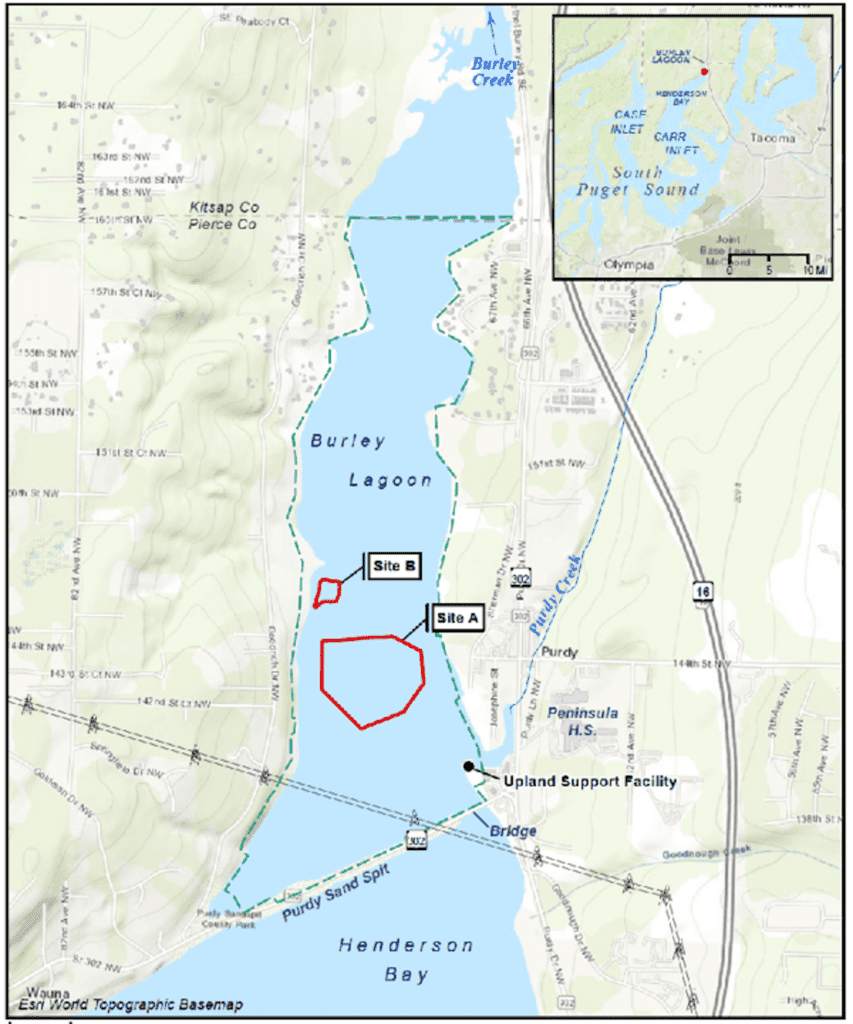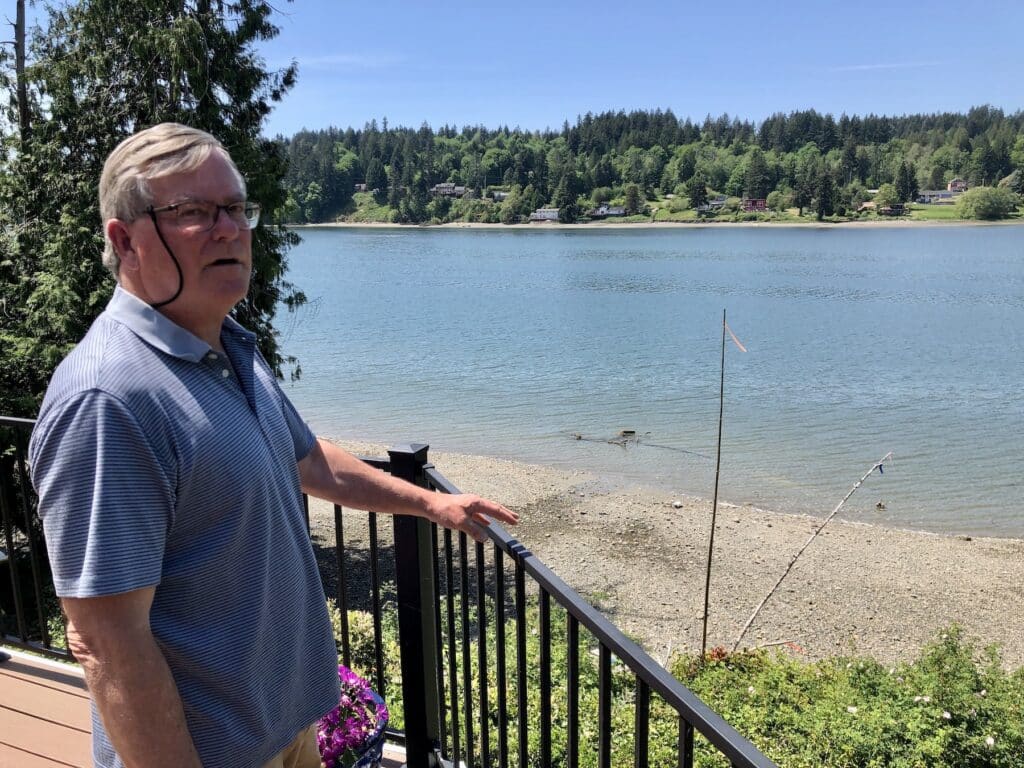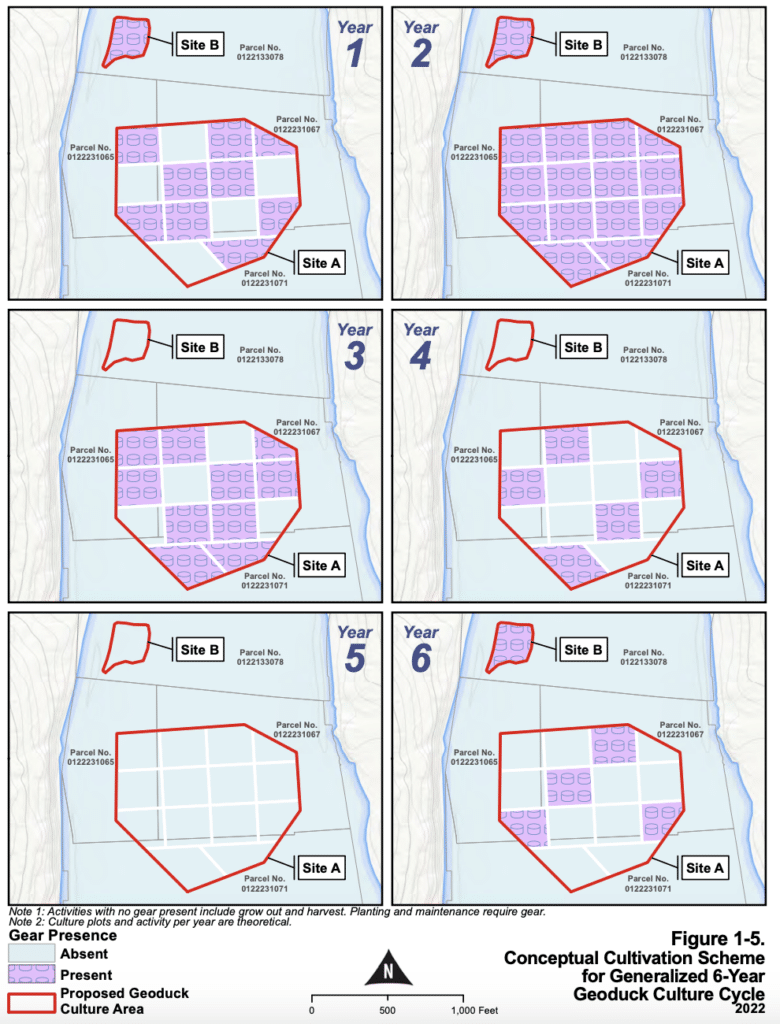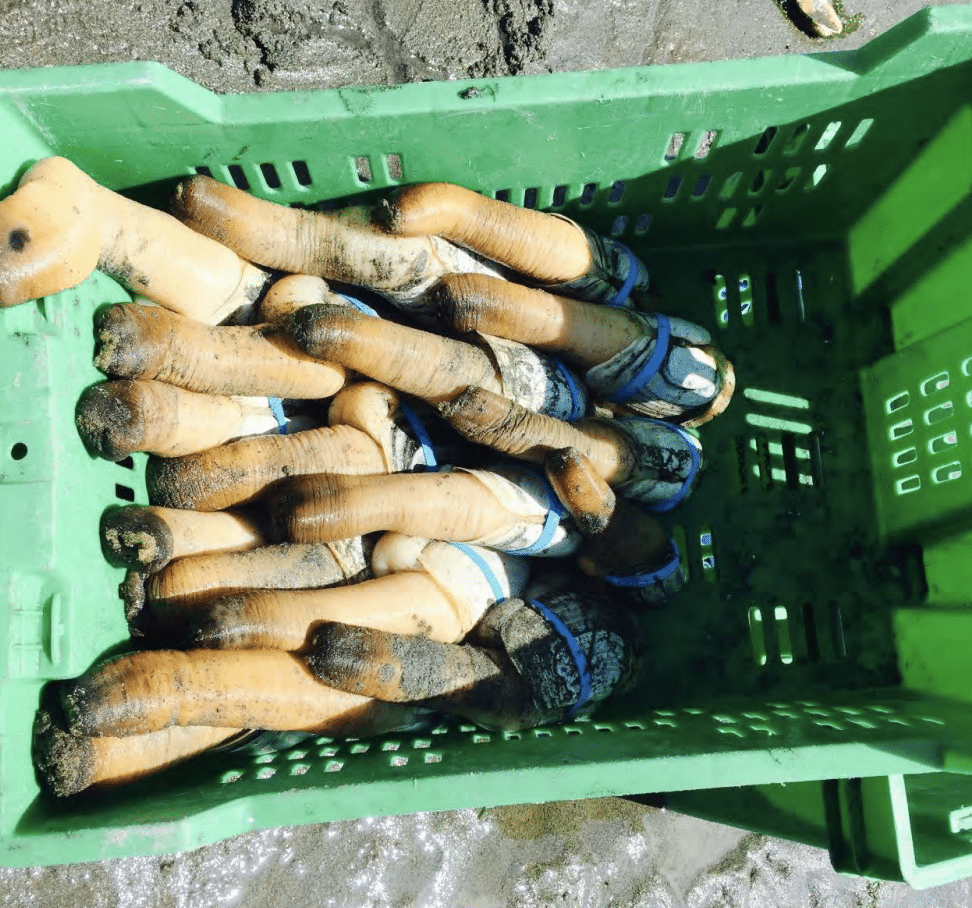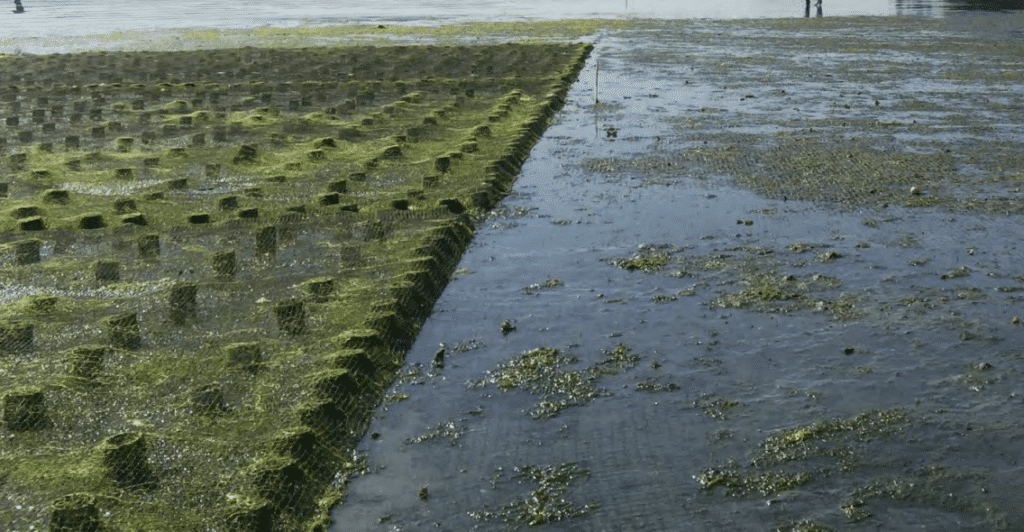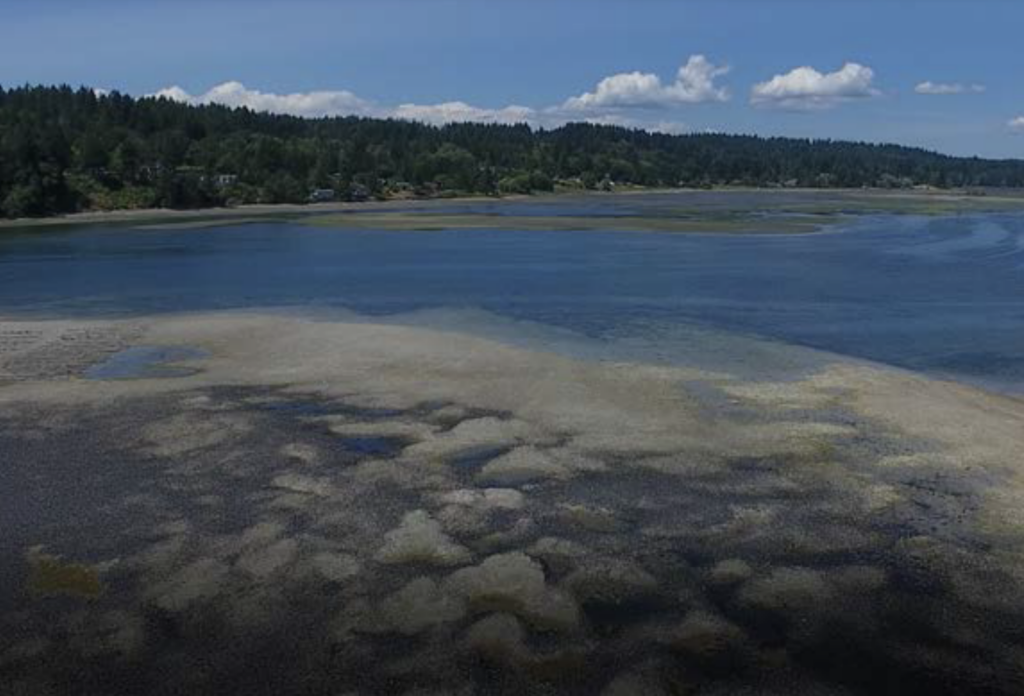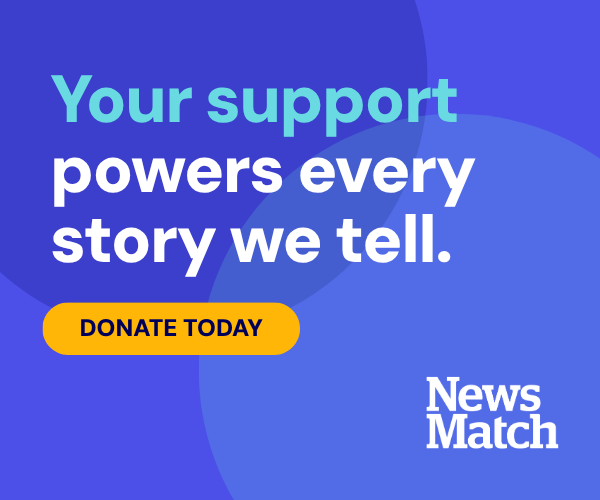Community Environment
Meetings next week to address Burley Lagoon geoduck farm proposal
Foes of a proposal to farm geoduck clams in Burley Lagoon hope to chip away during public meetings next week at a scientific study that found the activity would result in negligible to minor environmental effects.
Community Sponsor
Community stories are made possible in part by Peninsula Light Co, a proud sponsor of Gig Harbor Now.
Taylor Shellfish is pursuing shoreline substantial development and shoreline conditional use permits to convert 25.5 acres of Manila clam and oyster cultivation to growing geoducks. The large, long-necked clams would be planted, in phases, in plastic tubes. They and possibly plastic predator-exclusion netting would be used during the first half of the geoducks’ 6-year growing cycle.
A final environmental impact statement, issued Jan. 6, states that “no impacts were shown to have more than a temporary moderate impact based on best available science. … With the possible exception of aesthetics and recreation, no significant unavoidable adverse impacts were identified.”
Many residents disagree. They will make their case during three meetings of local land use advisory commissions.
The first will be a joint meeting Monday before the Gig Harbor Peninsula and Key Peninsula commissions. The event will run from 6 to 9 p.m. at Key Peninsula Civic Center, 17010 South Vaughn Road in Vaughn.
Public can only testify Monday
Taylor Shellfish and Pierce County will make 10-minute presentations. Of the three meetings, this will be the only one at which the public can testify. Speakers will be limited to 2 minutes each. It will not be a question-and-answer session.
To participate remotely click here or call (253) 215-8782, then enter the meeting ID: 915 5550 6834, and Passcode: 253.
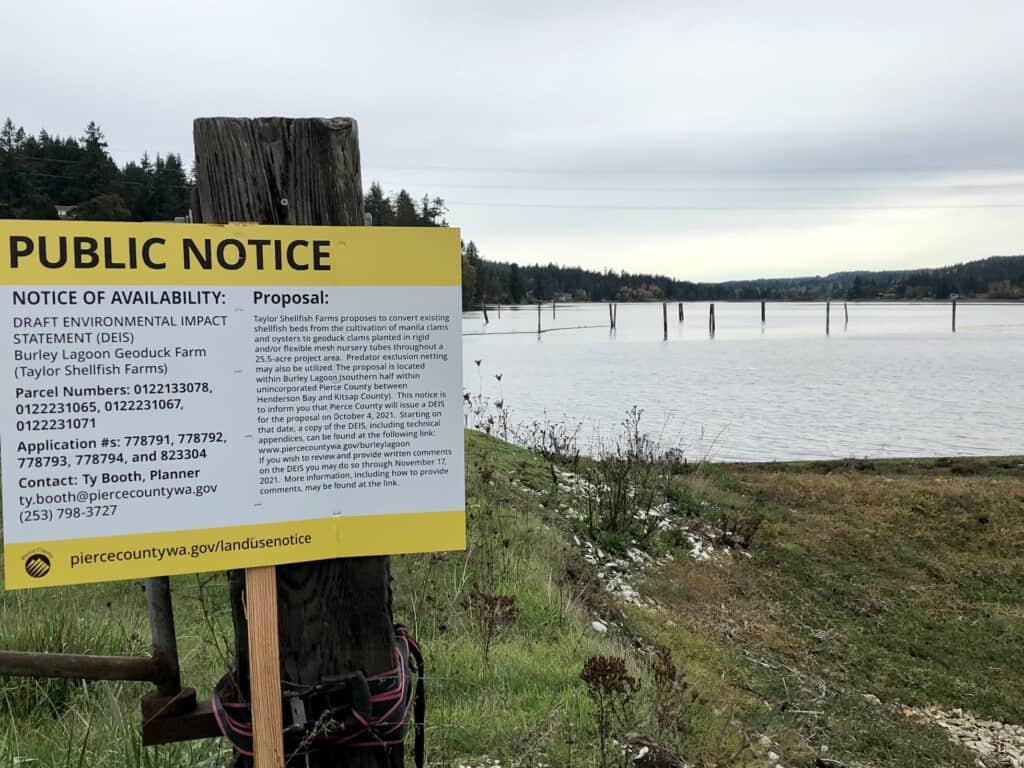
Taylor Shellfish wants to switch from farming Manila clams and oysters in Burley Lagoon to geoducks. Ed Friedrich / Gig Harbor Now
The Gig Harbor commission will meet from 6:30 to 8:30 p.m. Wednesday, May 24, at Gig Harbor Civic Center, 3510 Grandview St. The following night, the Key Peninsula commission will meet from 6 to 8 p.m. at Key Peninsula Civic Center.
The public can attend the meetings, but won’t be allowed to testify. Remote atendance is not an option for either event.
The purpose of the latter meetings is for the voluntary advisory boards to ask questions of Taylor and the county. Then board members will deliberate and make a recommendation on the proposal.
The Pierce County Hearing Examiner will consider their recommendations and hold a public hearing later this year. The examiner will make the final county decision on whether the shoreline permits should be approved, approved with conditions, or denied. He will also consider an appeal by four groups of the final environmental impact statement.
State Ecology Department has final say
The county will then submit the decision to the Washington Department of Ecology for approval, approval with conditions, or denial. Ecology makes the final decision.
Burley Lagoon tidelands were approved for commercial shellfish aquaculture in 1895, and have been continuously farmed for more than 100 years. The tidelands are privately owned by the Yamashita family.
Taylor entered into a lease in 2012 and took over management and operation of clam and oyster aquaculture in the estuary. The Shelton-based company leases 300 of the lagoon’s 400 acres. It applied to Pierce County in 2014-2015 for the shoreline permits to convert 25.5 acres to geoduck farming.
“I love oysters,” said Bruce Morse, who retired to the lagoon three years ago. “When I first moved here, I thought it was quaint they had an oyster farm, and it was that way, a family operation. Now it’s industrial-sized aquaculture. That’s what people complain about. It’s an industry, and they’re not good neighbors.”
The geoducks will be buried three to four per tube with the tubes a foot apart. That calculates to 37,000 tubes per acre, or about 1 million over the 25 acres. (Taylor says it plans to plant a patchwork of smaller plots and that there wouldn’t be 1 million tubes at the same time.)
Each clam will weigh about a pound, said Morse.
The equivalent of 1,000 cows
“That’s a lot of biomass,” he said. “That’s the equivalent to over 1,000 cows.”
And it’s not normal, he added. The geoducks would grow up to 42 times closer together than they live naturally.
“They’re essentially taking a critical habitat out of business, turning it into an industrial feedlot,” said Morse. “There are not many Burley Lagoons out there.”

Geoducks planted in tubes on May 8 in Squamish Harbor west of the Hood Canal Bridge. The plastic tubes are spaced a foot apart.
Because the proposed farm would be larger than usual and in a confined lagoon, Taylor and the county agreed that an environmental impact study should be conducted. The process has taken more than six years.
Study’s objectivity questioned
Neighbors are concerned about the amount of plastic that would be introduced into the lagoon. They also worry that harvesting the geoducks with pressurized water wands will disturb the sediment and create noise.
EIS scientists didn’t find such problems. Proponents say that’s to be expected, because they were selected and paid by Taylor.
“You can cherry pick the science,” said Morse, who earned master’s and doctorate degrees in Ecology. “You can pick and choose what science you want. It’s biased. Many of the studies were funded by Taylor themselves or by the shellfish industry and were not necessarily peer reviewed.”
Taylor stands behind the research.
“That final environmental impact study is one of the most robust assessments on geoduck culture developed to date,” said spokesman Bill Dewey. “That analysis took more than six years to complete and examines all of the critical environmental issues, including many identified during the outreach and scoping, using highly qualified consultants that were reviewed and accepted by the county.
County approved consultants
“We conducted an exhaustive, science-based review of the proposal, a really comprehensive piece of work. We went out for public comment which added to the depth of analysis, and we were able to respond to concerns that came in. So we really feel confident in that FEIS as a valuable tool to evaluate the effects of the project.”
John and Karen McDonell have lived alongside Burley Lagoon for 40 years. She says she’s fighting the proposal because Taylor wants to place a 25-acre geoduck farm in a residential community.
“We who live along the shoreline, it’ll be like our entire front yard,” she said. “It’ll affect our recreation and be loud because they harvest the geoducks using diesel-powered compressors with hydraulic wands.”
She correlates the proposal with cigarette companies’ tobacco science from her childhood that showed smoking wasn’t harmful.
“This PVC solution is not ecologically bad. It’s just plastic, a million tubes of plastic in the middle of a pristine estuary,” she said, sarcastically. “One of the things that makes me sick to my stomach is that we all chose to live here. Many, many people inherited their grandparents’ places, chose to live here because it’s like living on golden pond — quiet, serene, beautiful, where you see the web of life.”
McDonell doesn’t want to breath diesel fumes when she’s having dinner on the deck with company, smell seaweed baking on predator-protection nets, or view plastic tubes and nets.
“That argument should not win the day that it’s OK to have aquaculture farms that have such a debilitating effect on the environment and imperil salmon and other species,” she said.
Geoduck nursery gear would be visible up to about 28% to 30% of daylight hours between May and August and for less than 3.2% of daytime hours between November and January, according to the study.
Taylor says it works hard at being good neighbors and stewards of the environment.
Other farms haven’t caused problems
“We have a lot of experience farming geoducks,” Dewey said. “We started in the 1990s and commercialized in the 2000s, and we’re not seeing any significant effects on the beaches we’re farming.”
Morse figures that Taylor Shellfish earns close to $68 million revenue over 10 years from Burley Lagoon, even without the geoducks. Water leases the company pays pale in comparison to residents’ property taxes.
“Burley Lagoon is screwed,” he said. “We take all the damage but get no reward. All that money goes out of Pierce County. The product is being shipped over to China.”
Taylor says it sells locally, nationally and internationally.
Heather McFarlane lives in the house that her parents built on the east shore in 1964. The 86-year-old heads up the nonprofit advocacy group Friends of Burley Lagoon.
“We all have obvious major concerns,” she said. “Putting a geoduck farm in here would be outrageous and destructive.”
With only two minutes each to speak Monday, group members are splitting up the issues.
“I’m going to challenge the permit altogether because of the potential impact on marine mammals,” McFarlane said.
There has never been an examination of a geoduck farm’s cumulative effects, Morse said.
“You may not see one thing that you can identify as a silver bullet that killed (the lagoon), but 1,000 cuts killed it,” he said. “It’s many, many, many things that accumulated over time. There’s never been an analysis of the cumulative effects.”


